
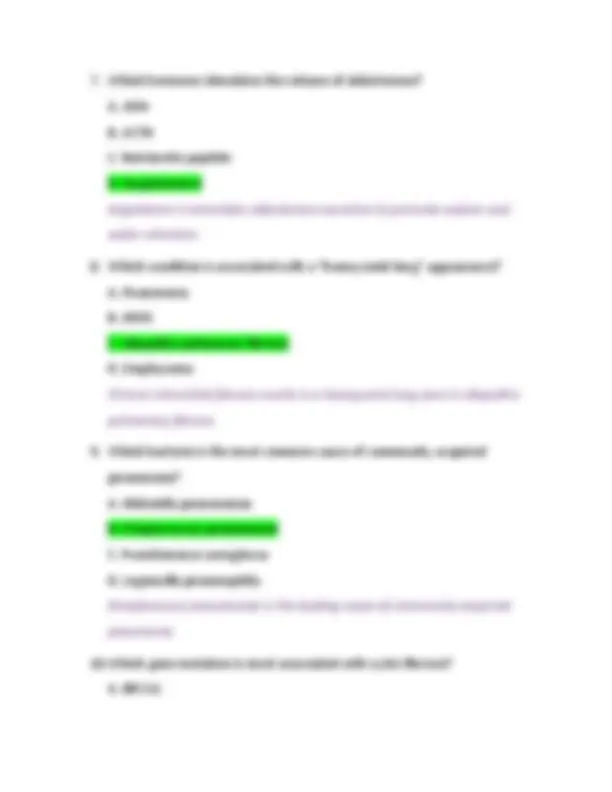
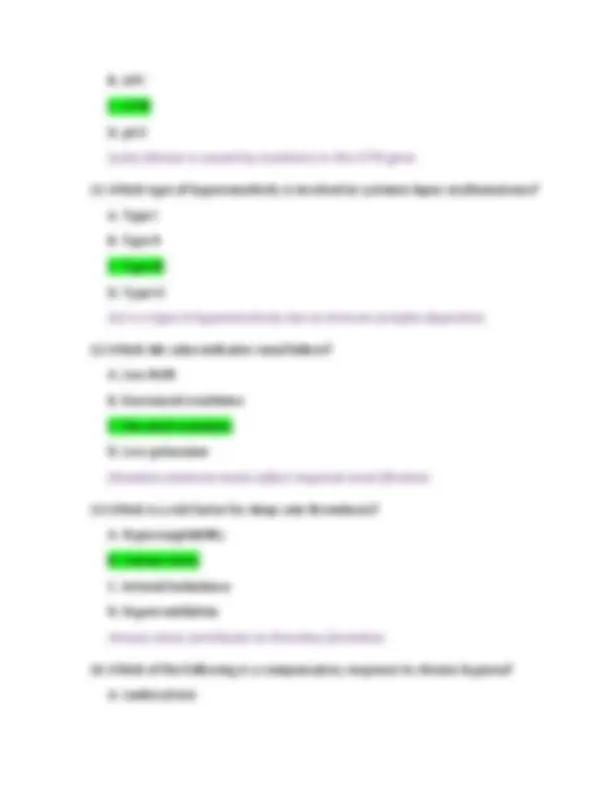
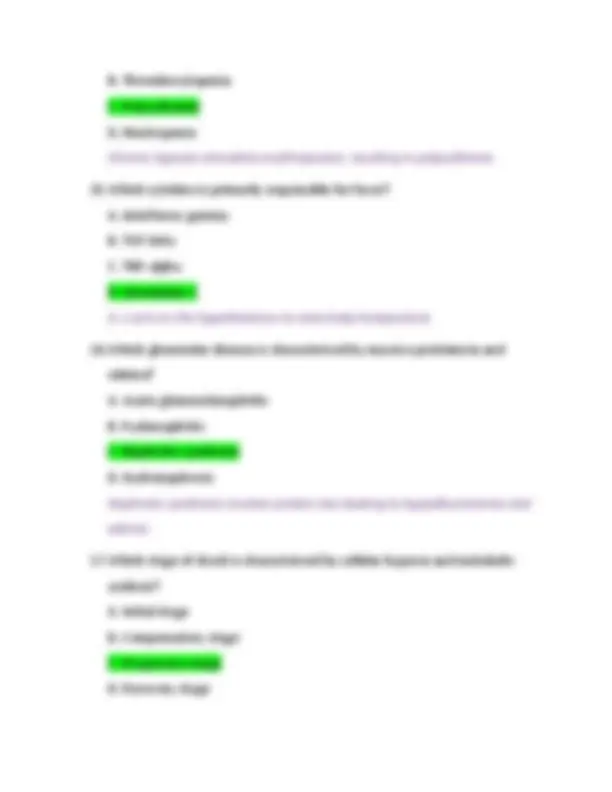
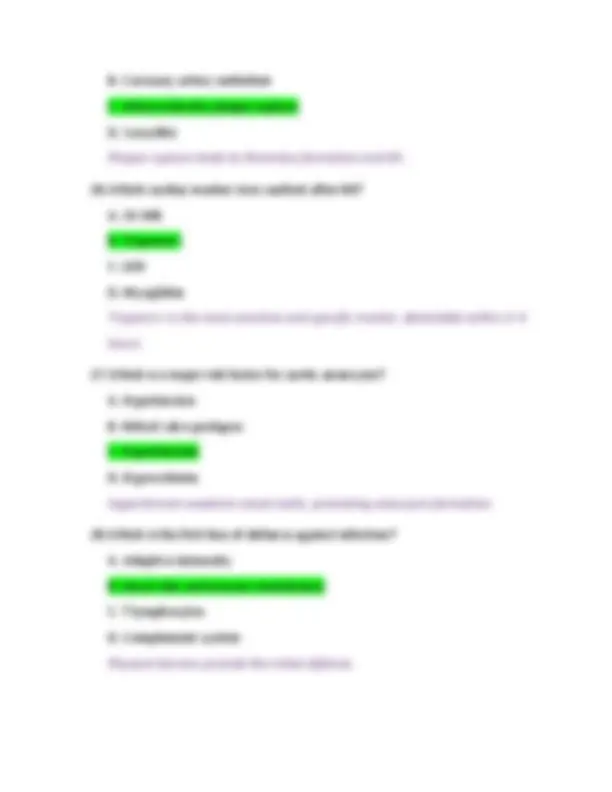
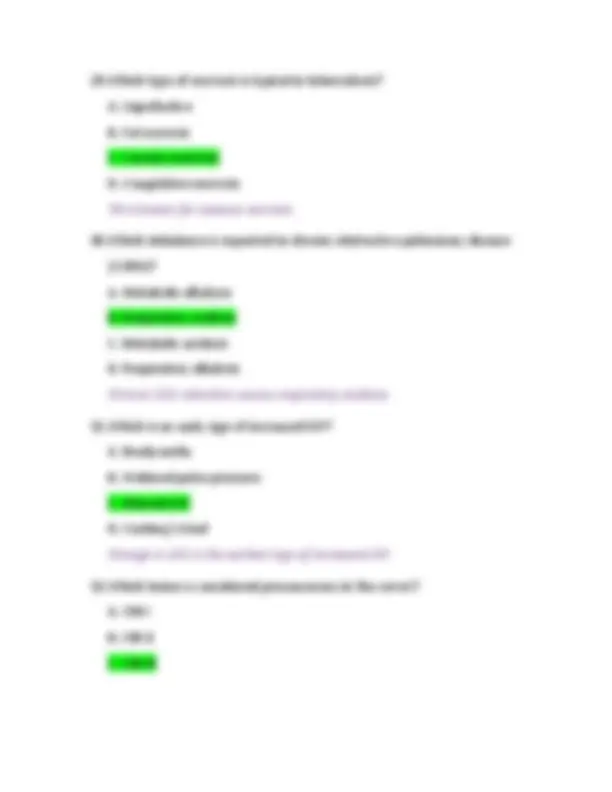
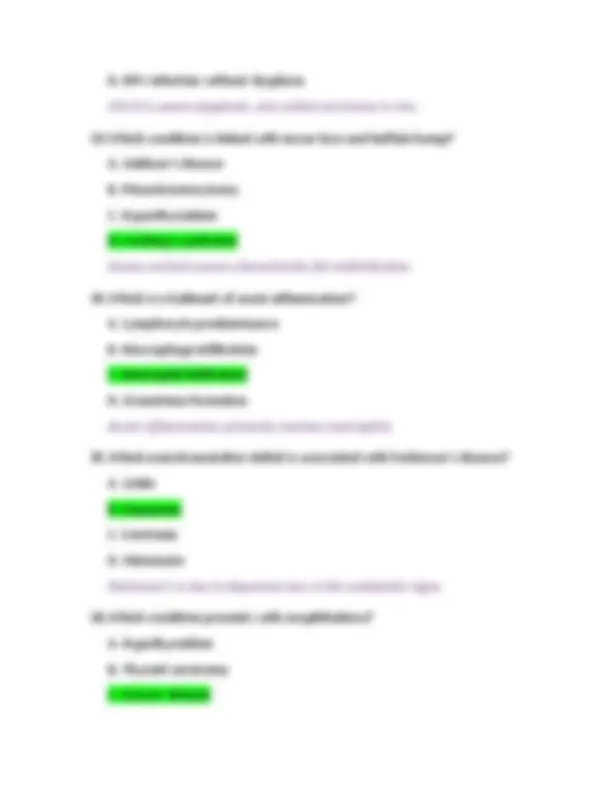
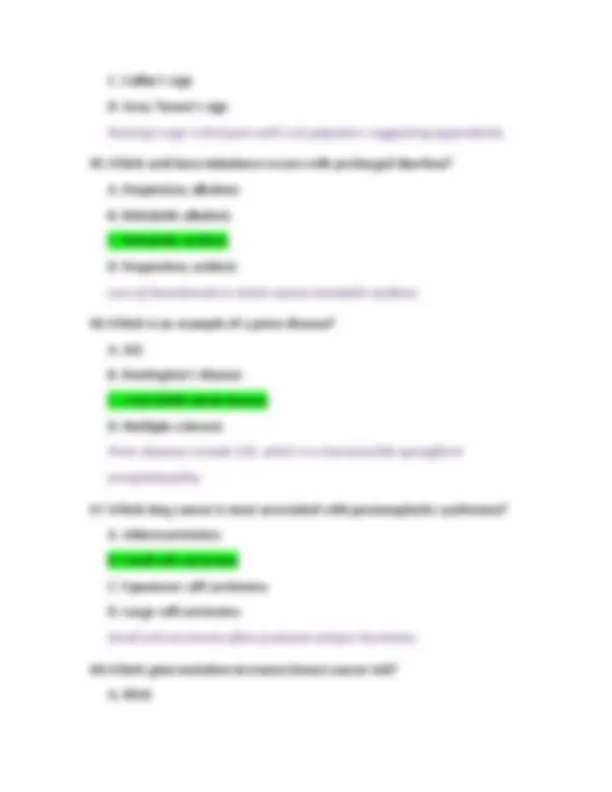
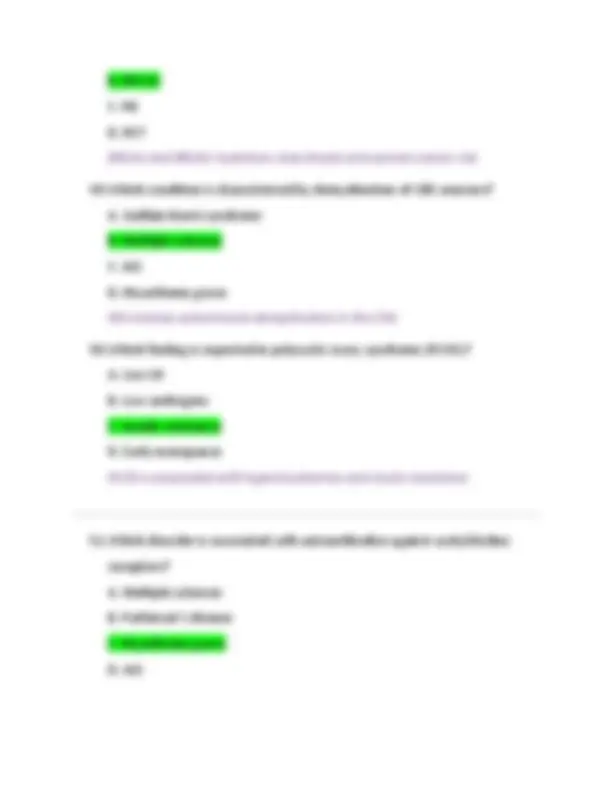
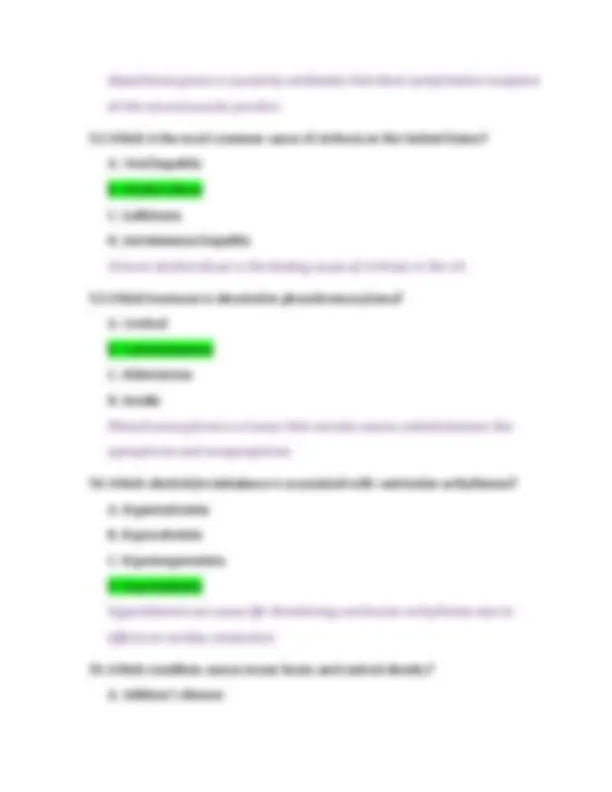
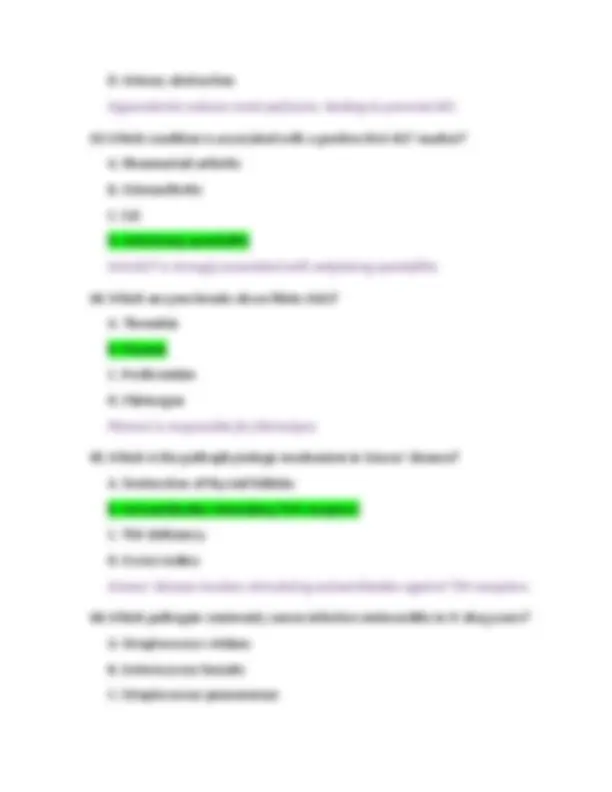
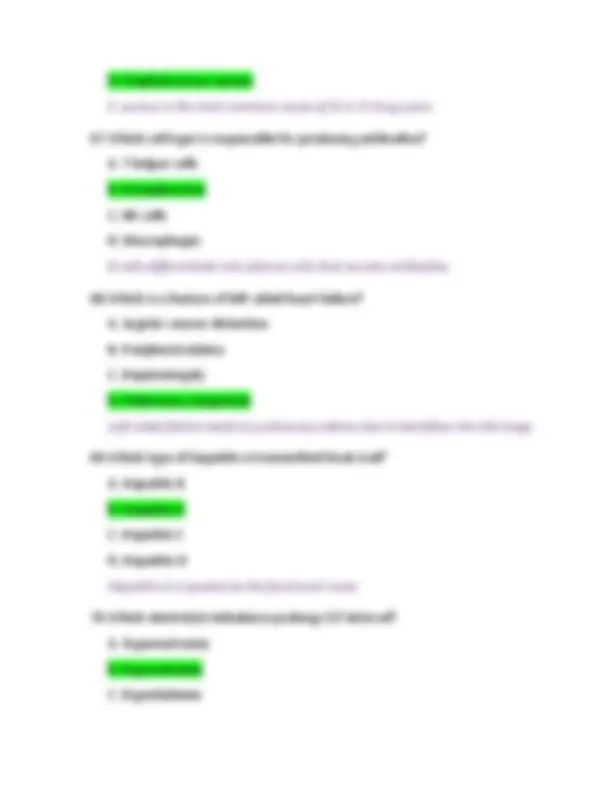
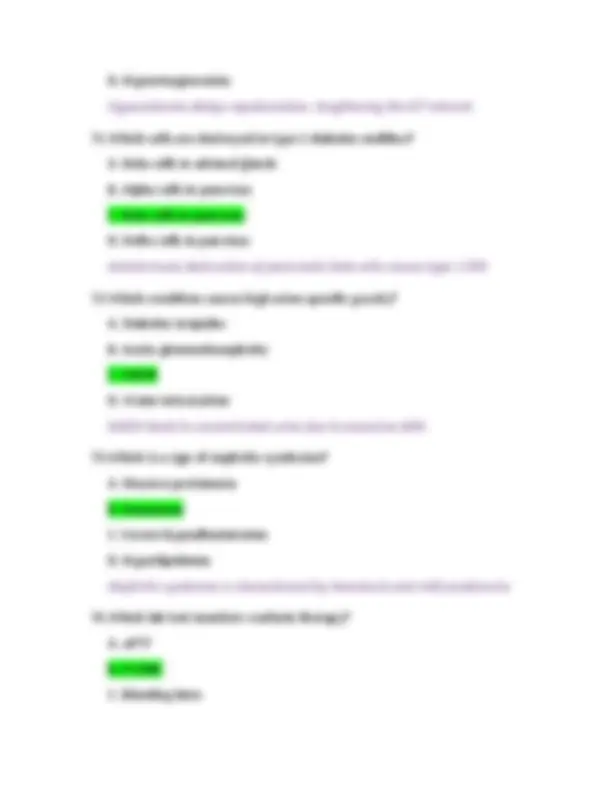
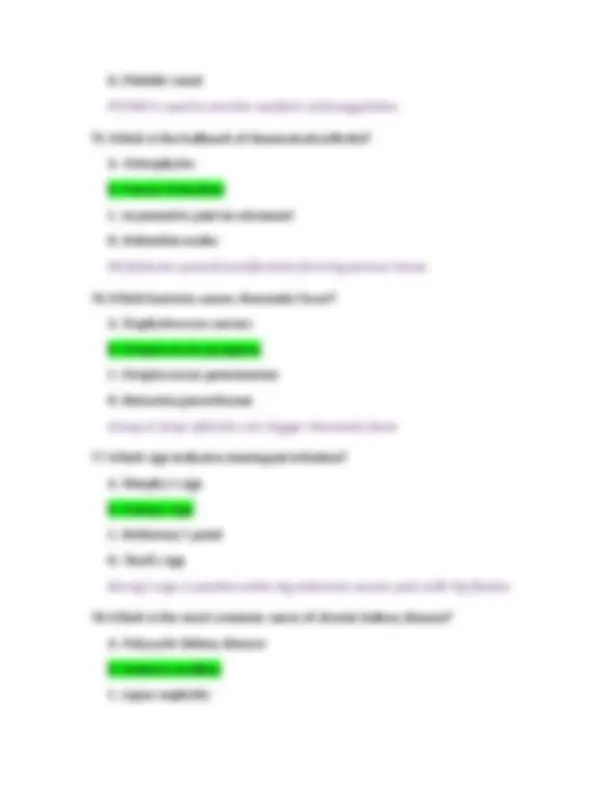
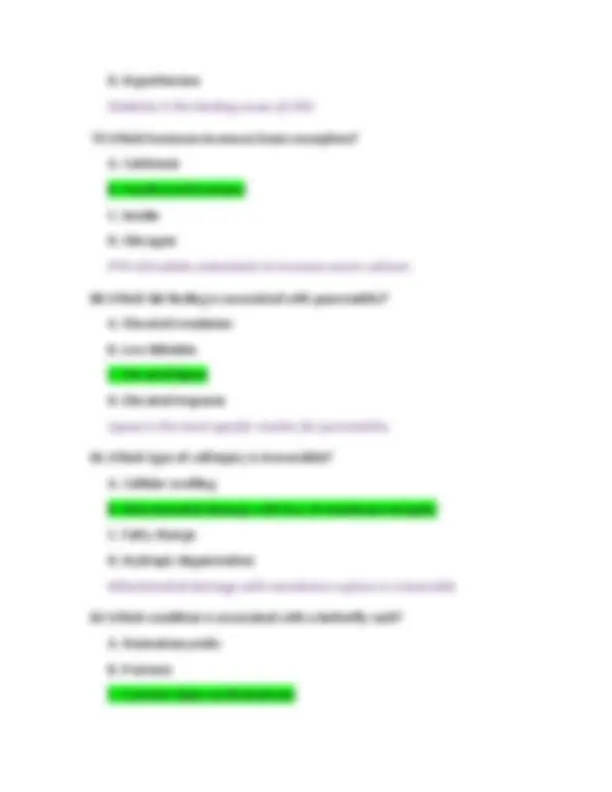
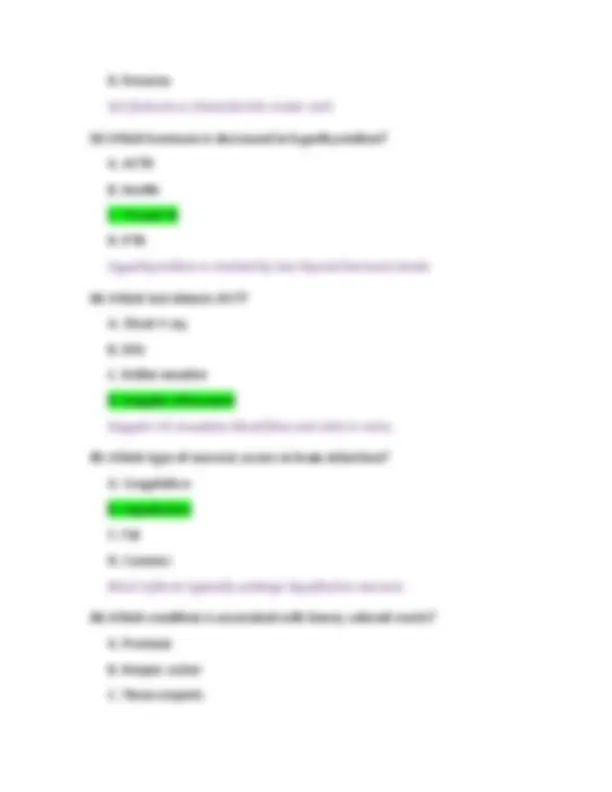
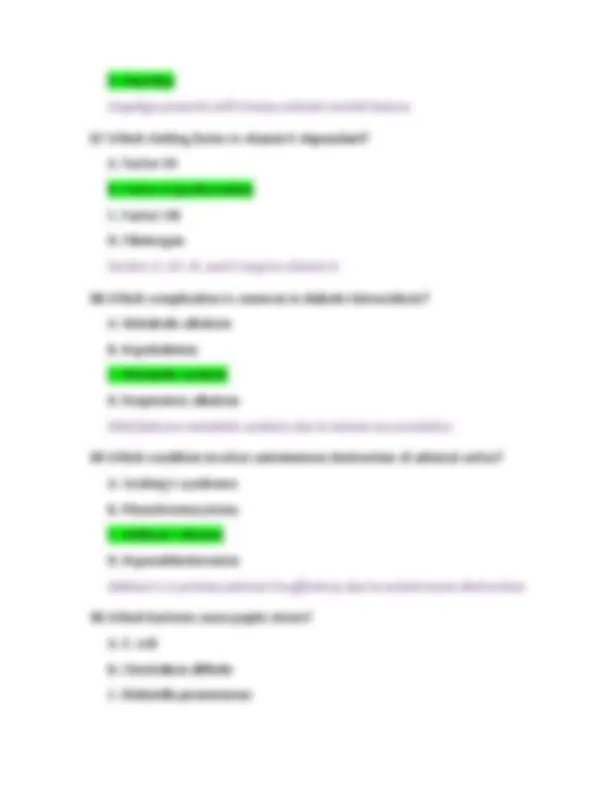

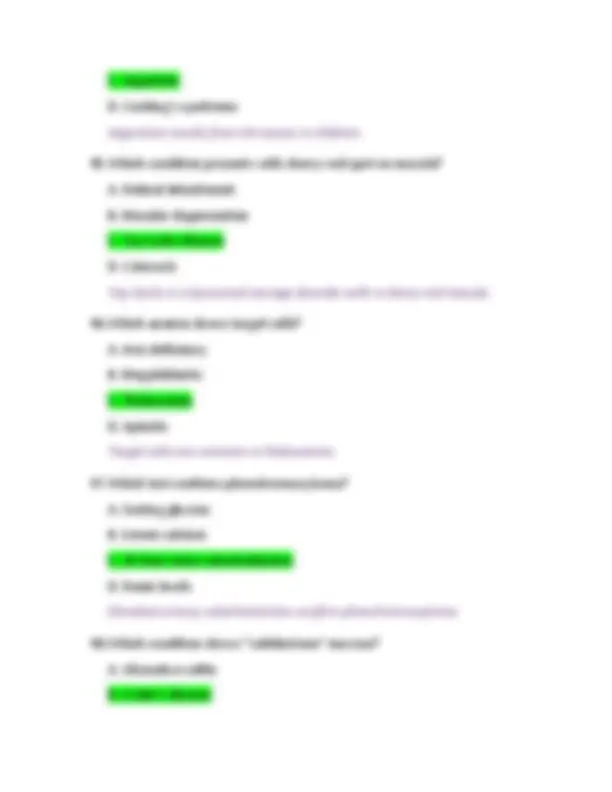



Study with the several resources on Docsity

Earn points by helping other students or get them with a premium plan


Prepare for your exams
Study with the several resources on Docsity

Earn points to download
Earn points by helping other students or get them with a premium plan
Community
Ask the community for help and clear up your study doubts
Discover the best universities in your country according to Docsity users
Free resources
Download our free guides on studying techniques, anxiety management strategies, and thesis advice from Docsity tutors
NSG 6005 – Advanced Pathophysiology Exam Questions And Correct Answers (Verified Answers) Plus Rationales 2025 Q&A | Instant Download PDF South University
Typology: Exams
1 / 27

This page cannot be seen from the preview
Don't miss anything!




















C. Decreased capillary permeability D. Lymphatic obstruction In CHF, increased hydrostatic pressure pushes fluid out into the interstitial space, causing edema.
D. p Cystic fibrosis is caused by mutations in the CFTR gene. 11.Which type of hypersensitivity is involved in systemic lupus erythematosus? A. Type I B. Type II C. Type III D. Type IV SLE is a type III hypersensitivity due to immune complex deposition. 12.Which lab value indicates renal failure? A. Low BUN B. Decreased creatinine C. Elevated creatinine D. Low potassium Elevated creatinine levels reflect impaired renal filtration. 13.Which is a risk factor for deep vein thrombosis? A. Hypocoagulability B. Venous stasis C. Arterial turbulence D. Hyperventilation Venous stasis contributes to thrombus formation. 14.Which of the following is a compensatory response to chronic hypoxia? A. Leukocytosis
B. Thrombocytopenia C. Polycythemia D. Neutropenia Chronic hypoxia stimulates erythropoiesis, resulting in polycythemia. 15.Which cytokine is primarily responsible for fever? A. Interferon-gamma B. TGF-beta C. TNF-alpha D. Interleukin- 1 IL-1 acts on the hypothalamus to raise body temperature. 16.Which glomerular disease is characterized by massive proteinuria and edema? A. Acute glomerulonephritis B. Pyelonephritis C. Nephrotic syndrome D. Hydronephrosis Nephrotic syndrome involves protein loss leading to hypoalbuminemia and edema. 17.Which stage of shock is characterized by cellular hypoxia and metabolic acidosis? A. Initial stage B. Compensatory stage C. Progressive stage D. Recovery stage
HPV infection, especially types 16 and 18, is strongly linked to cervical cancer. 22.Which hematologic malignancy shows Reed-Sternberg cells? A. Multiple myeloma B. Non-Hodgkin lymphoma C. Hodgkin lymphoma D. Chronic lymphocytic leukemia Reed-Sternberg cells are pathognomonic for Hodgkin lymphoma. 23.Which hormone imbalance causes acromegaly? A. Cortisol excess B. Growth hormone excess C. TSH excess D. Prolactin deficiency Excess growth hormone in adults causes acromegaly. 24.Which type of anemia is due to vitamin B12 deficiency? A. Microcytic hypochromic anemia B. Normocytic normochromic anemia C. Macrocytic anemia D. Hemolytic anemia Vitamin B12 deficiency causes macrocytic anemia due to impaired DNA synthesis. 25.Which is the most common cause of myocardial infarction? A. Coronary artery spasm
B. Coronary artery embolism C. Atherosclerotic plaque rupture D. Vasculitis Plaque rupture leads to thrombus formation and MI. 26.Which cardiac marker rises earliest after MI? A. CK-MB B. Troponin I C. LDH D. Myoglobin Troponin I is the most sensitive and specific marker, detectable within 3– 4 hours. 27.Which is a major risk factor for aortic aneurysm? A. Hypotension B. Mitral valve prolapse C. Hypertension D. Hypovolemia Hypertension weakens vessel walls, promoting aneurysm formation. 28.Which is the first line of defense against infection? A. Adaptive immunity B. Intact skin and mucous membranes C. T lymphocytes D. Complement system Physical barriers provide the initial defense.
D. HPV infection without dysplasia CIN III is severe dysplasia, also called carcinoma in situ. 33.Which condition is linked with moon face and buffalo hump? A. Addison’s disease B. Pheochromocytoma C. Hyperthyroidism D. Cushing’s syndrome Excess cortisol causes characteristic fat redistribution. 34.Which is a hallmark of acute inflammation? A. Lymphocyte predominance B. Macrophage infiltration C. Neutrophil infiltration D. Granuloma formation Acute inflammation primarily involves neutrophils. 35.Which neurotransmitter deficit is associated with Parkinson’s disease? A. GABA B. Dopamine C. Serotonin D. Glutamate Parkinson’s is due to dopamine loss in the substantia nigra. 36.Which condition presents with exophthalmos? A. Hypothyroidism B. Thyroid carcinoma C. Graves’ disease
D. Hashimoto’s thyroiditis Graves’ disease involves autoantibodies stimulating the thyroid and orbital tissues. 37.Which ECG change is classic for hypokalemia? A. Peaked T waves B. Short QT interval C. U waves D. ST elevation Hypokalemia can produce U waves on ECG. 38.Which is a risk factor for peptic ulcer disease? A. High fiber diet B. Proton pump inhibitors C. H. pylori infection D. NSAID use NSAIDs inhibit prostaglandins that protect the gastric mucosa. 39.Which enzyme is deficient in phenylketonuria (PKU)? A. Glucose- 6 - phosphate dehydrogenase B. Hexosaminidase A C. Phenylalanine hydroxylase D. Pyruvate kinase PKU is due to deficiency of phenylalanine hydroxylase. 40.Which is the pathophysiology of asthma? A. Permanent alveolar damage B. Fibrosis of alveolar walls
C. Cullen’s sign D. Grey-Turner’s sign Rovsing’s sign is RLQ pain with LLQ palpation, suggesting appendicitis. 45.Which acid-base imbalance occurs with prolonged diarrhea? A. Respiratory alkalosis B. Metabolic alkalosis C. Metabolic acidosis D. Respiratory acidosis Loss of bicarbonate in stools causes metabolic acidosis. 46.Which is an example of a prion disease? A. ALS B. Huntington’s disease C. Creutzfeldt-Jakob disease D. Multiple sclerosis Prion diseases include CJD, which is a transmissible spongiform encephalopathy. 47.Which lung cancer is most associated with paraneoplastic syndromes? A. Adenocarcinoma B. Small cell carcinoma C. Squamous cell carcinoma D. Large cell carcinoma Small cell carcinoma often produces ectopic hormones. 48.Which gene mutation increases breast cancer risk? A. KRAS
BRCA1 and BRCA2 mutations raise breast and ovarian cancer risk. 49.Which condition is characterized by demyelination of CNS neurons? A. Guillain-Barré syndrome B. Multiple sclerosis C. ALS D. Myasthenia gravis MS involves autoimmune demyelination in the CNS. 50.Which finding is expected in polycystic ovary syndrome (PCOS)? A. Low LH B. Low androgens C. Insulin resistance D. Early menopause PCOS is associated with hyperinsulinemia and insulin resistance. 51.Which disorder is associated with autoantibodies against acetylcholine receptors? A. Multiple sclerosis B. Parkinson’s disease C. Myasthenia gravis D. ALS
B. Hypothyroidism C. Cushing’s syndrome D. Hyperparathyroidism Cushing’s syndrome involves cortisol excess, leading to fat redistribution. 56.Which type of shock results from severe allergic reactions? A. Hypovolemic B. Anaphylactic C. Cardiogenic D. Neurogenic Anaphylactic shock is a severe IgE-mediated reaction causing massive vasodilation. 57.Which tumor marker is elevated in prostate cancer? A. CEA B. PSA C. AFP D. CA- 125 Prostate-specific antigen (PSA) is used for prostate cancer screening and monitoring. 58.Which is a modifiable risk factor for coronary artery disease? A. Age B. Gender C. Smoking D. Family history Smoking is a major modifiable risk factor for CAD.
59.Which condition features microcytic hypochromic anemia? A. Pernicious anemia B. Iron deficiency anemia C. Aplastic anemia D. Anemia of chronic disease Iron deficiency anemia produces small, pale RBCs. 60.Which part of the nephron is primarily responsible for glucose reabsorption? A. Loop of Henle B. Proximal convoluted tubule C. Distal convoluted tubule D. Collecting duct Most glucose reabsorption occurs in the proximal tubule. 61.Which hormone is deficient in diabetes insipidus? A. Aldosterone B. Cortisol C. Insulin D. Antidiuretic hormone Diabetes insipidus is due to lack of ADH or renal resistance to it. 62.Which is a cause of prerenal acute kidney injury? A. Nephrotoxic drugs B. Glomerulonephritis C. Hypovolemia
D. Staphylococcus aureus S. aureus is the most common cause of IE in IV drug users. 67.Which cell type is responsible for producing antibodies? A. T helper cells B. B lymphocytes C. NK cells D. Macrophages B cells differentiate into plasma cells that secrete antibodies. 68.Which is a feature of left-sided heart failure? A. Jugular venous distention B. Peripheral edema C. Hepatomegaly D. Pulmonary congestion Left-sided failure leads to pulmonary edema due to backflow into the lungs. 69.Which type of hepatitis is transmitted fecal-oral? A. Hepatitis B B. Hepatitis A C. Hepatitis C D. Hepatitis D Hepatitis A is spread via the fecal-oral route. 70.Which electrolyte imbalance prolongs QT interval? A. Hypernatremia B. Hypocalcemia C. Hyperkalemia
D. Hypermagnesemia Hypocalcemia delays repolarization, lengthening the QT interval. 71.Which cells are destroyed in type 1 diabetes mellitus? A. Beta cells in adrenal glands B. Alpha cells in pancreas C. Beta cells in pancreas D. Delta cells in pancreas Autoimmune destruction of pancreatic beta cells causes type 1 DM. 72.Which condition causes high urine specific gravity? A. Diabetes insipidus B. Acute glomerulonephritis C. SIADH D. Water intoxication SIADH leads to concentrated urine due to excessive ADH. 73.Which is a sign of nephritic syndrome? A. Massive proteinuria B. Hematuria C. Severe hypoalbuminemia D. Hyperlipidemia Nephritic syndrome is characterized by hematuria and mild proteinuria. 74.Which lab test monitors warfarin therapy? A. aPTT B. PT/INR C. Bleeding time